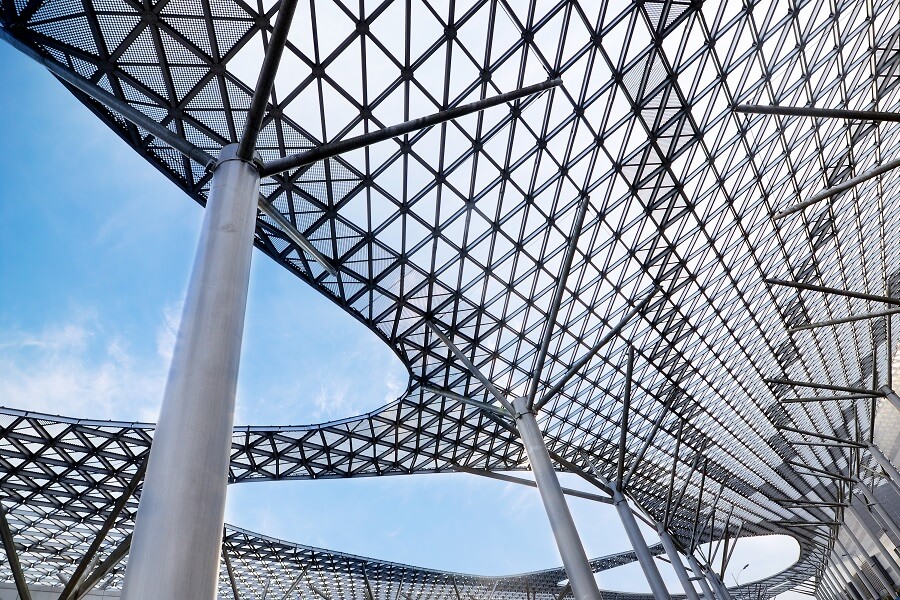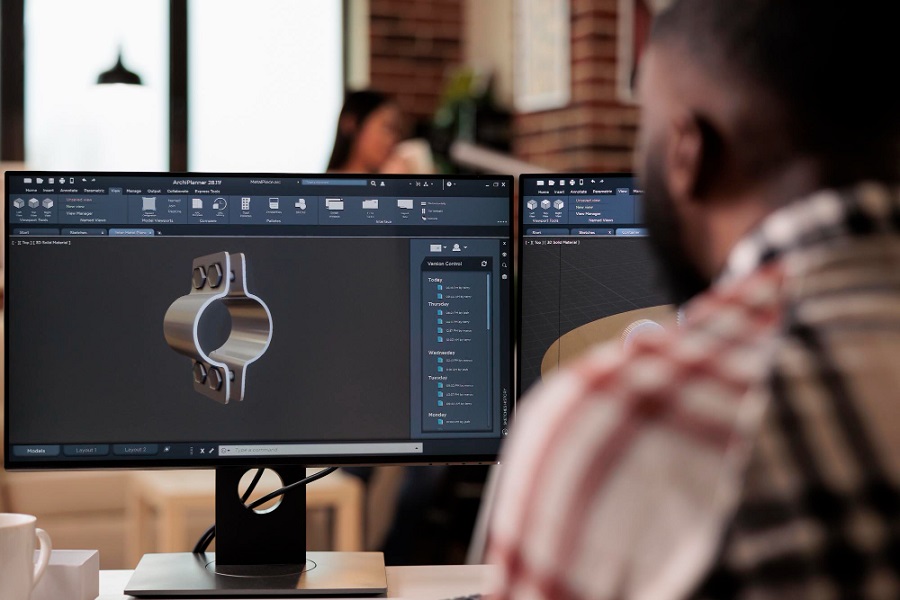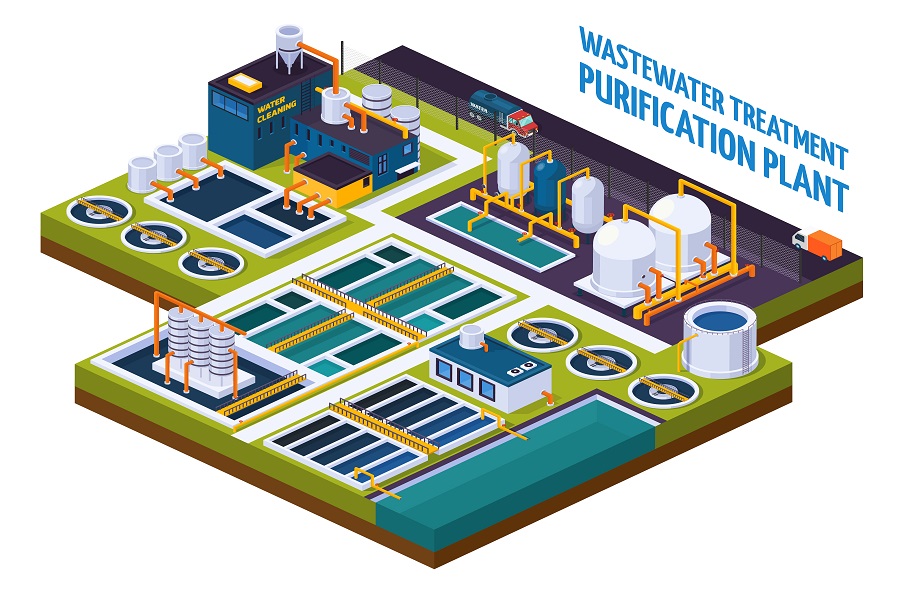Steel detailing has always played a critical role in the construction industry, providing the detailed plans and drawings necessary for the fabrication and erection of steel structures. However, with the rapid advancement of technology, a new era of futuristic steel detailing is emerging.
Powered by artificial intelligence (AI) and supported by cutting-edge technologies, this new wave in structural steel detailing is revolutionizing the way we design, visualize, and construct steel structures. Let’s explore the exciting world of futuristic steel detailing, delving into its various aspects and the profound impact it is having on the construction industry.
What is Structural Steel Detailing?
Steel Detailing is a meticulous and comprehensive process of creating detailed drawings, plans, and information for the fabrication and erection of steel structures. It involves translating the design intent provided by architects and engineers into clear and precise documentation that steel fabricators and erectors can use. Structural steel detailing includes essential information such as the dimensions, connections, and quantities of steel members, ensuring accurate fabrication and construction.
Steel Detailing – The Traditional Approach
For many years, steel detailing relied on manual drafting techniques, where detailers meticulously created structural steel drawings by hand using drafting tools. These hand-drawn 2D drawings, including plans, elevations, and sections, served as the primary means of communication for conveying the design intent and dimensions of each steel component.
Steel detailers created comprehensive sets of detailed drawings, including general arrangement drawings, steel fabrication drawings, and erection drawings, which were drafted and duplicated for distribution. Manual calculations were performed to determine member sizes and connection details, involving mathematical equations and reference manuals.
However, the traditional approach to steel drafting and detailing had several drawbacks, like:
- Limited visualization and communication
- Limited flexibility in design iterations
- Difficulty in collaboration
- Increased potential for errors
- Costly reworks
- Inefficiencies in fabrication and construction, leading to significant project delays and compromised structural integrity
The Need for Modern and Futuristic Steel Detailing Technologies
These drawbacks prompted the need for more advanced, modern structural steel drafting services that can enhance precision, visualization, communication, collaboration, and sustainability in steel detailing practices.
Today, by embracing modern technologies, architects, engineers, structural steel detailers, fabricators, and erectors are streamlining processes, improving project outcomes, reducing errors and rework, optimizing designs, and delivering high-quality, efficient, and sustainable steel structures.
Let’s look at some of the latest and futuristic technologies in structural steel drafting and detailing.
1. Computer-Aided Design (CAD) Software
CAD software, such as AutoCAD, Tekla Structures, Advance Steel, SketchUp, and SolidWorks has revolutionized the steel detailing process by providing advanced tools and features and exceptional parametric modeling capabilities. These software automate the generation of steel fabrication drawings, ensuring superior optimization capabilities, enhanced design iteration and visualization, and seamless coordination between different stakeholders.
In fact, the implementation of CAD software in steel detailing has led to significant improvements in efficiency, with studies indicating a reduction of up to 40% in detailing time compared to manual methods – making it an essential tool in the modern construction industry.
2. 3D Building Information Modeling (BIM)
BIM is a technology that enables the creation and management of detailed 3D models of the entire steel structure. It brings together various aspects of the project, including architectural, structural, and MEP (mechanical, electrical, and plumbing) systems. Revit services facilitate collaboration, improve coordination among project stakeholders, and enhance visualization and communication.
The integration of steel detailing information within comprehensive Building Information Modeling (BIM) services provides a significant boost to futuristic steel detailing. BIM platforms allow for seamless collaboration and coordination among various project stakeholders, including architects, engineers, and contractors. By incorporating steel detailing data into the BIM model, conflicts and clashes can be detected and resolved at an early stage, resulting in improved efficiency and reduced rework. BIM also enables the extraction of accurate quantity takeoffs, facilitating cost estimation and material procurement.
3. Automation and AI-Assisted Detailing
Today, automation and AI-assisted technologies have become indispensable in the steel detailing industry due to their ability to handle complex tasks and enhance the overall efficiency of construction. Thanks to automation, numerous repetitive and time-consuming tasks, like generating fabrication drawings, material lists, and reports, are performed swiftly and accurately, freeing detailers to focus on critical design aspects.
AI algorithms, too, help in optimizing design parameters, evaluating structural performance, and suggesting improvements, which in turn leads to cost savings, material efficiency, and enhanced structural integrity.
Furthermore, the integration of clash detection algorithms through AI technology helps identify clashes and interferences between steel components and other building systems early in the design phase. This early detection mitigates potential conflicts, reduces errors, and minimizes costly rework during fabrication and construction.
4. AR/VR in Steel Detailing
AR/VR (Augmented Reality/Virtual Reality) technologies have significantly impacted the field of steel detailing, offering immersive and interactive experiences that revolutionize the way steel structures are designed and reviewed. These technologies enhance visualization, coordination, communication, and safety throughout the steel detailing process.
While AR allows stakeholders to overlay virtual steel models onto the real-world construction site, VR provides a virtual environment where stakeholders can experience and validate complex steel structures before construction begins. This early identification enables superior clash detection, reduces errors, minimizes rework, and ensures efficient construction.
Additionally, AR/VR technologies aid in on-site construction assistance by providing real-time guidance for accurate assembly, connections, and sequencing. This immersive experience enhances client engagement, facilitates decision-making, and improves overall project communication.
The integration of AR/VR in steel detailing offers numerous other benefits too, including enhanced visualization, coordination, communication, and safety. These technologies optimize the design and construction processes, leading to improved project outcomes, increased collaboration, and heightened client satisfaction.
5. Robotics in Structural Steel Detailing
Robotics is an emerging technology that is finding applications in various industries, and structural steel detailing is no exception. Some ways in which robotics is being applied in this field include:
- 3D Scanning and Modeling: Robotic systems equipped with 3D scanners can capture precise measurements of existing structures for the creation of accurate 3D models of the steel structures. This not only eliminates the need for manual measurements but also speeds up structural steel modeling services and processes.
- Automated Detailing: Robotic software can automate the process of generating detailed drawings and plans based on 3D models. The software can analyze the structural design and generate accurate shop drawings, assembly drawings, and erection plans. This automation reduces the time and effort required for manual detailing and minimizes the chances of errors.
- Fabrication: Robotics are also being applied to automate various fabrication processes. For example, robotic arms can be used for tasks like cutting, drilling, and welding steel components.
- On-site Assembly and Erection: Robotic systems can assist in the assembly and erection of steel structures on-site. Mobile robotic platforms can be used to transport steel components, minimizing the manual effort required by workers. Additionally, robotic arms can be employed to position and connect steel elements accurately, ensuring proper alignment and reducing the chances of errors during the construction process.
- Quality Control and Inspection: Robotics can play a crucial role in the quality control and inspection of structural steel components. Vision systems and sensors integrated into robotic systems can detect defects, measure dimensions, and verify the accuracy of fabricated steel elements. This helps ensure that the final structure meets the required specifications and standards.
- COBie Services
COBie services have become increasingly essential in the building and construction industry. COBie, which stands for Construction Operations Building Information Exchange, is a standardized format for capturing and organizing building information throughout the project lifecycle. It enables seamless information exchange between various stakeholders, including architects, engineers, contractors, and facility managers. COBie facilitates the efficient transfer of data, ensuring accurate and comprehensive documentation of building components, equipment, and maintenance requirements.
By implementing COBie services, AEC professionals benefit from improved collaboration, streamlined project management, and enhanced facility operations and maintenance. It is a progressive step towards achieving digital transformation and maximizing efficiency in the building and construction sector.
Robotics + AI + AR/VR + BIM – The Future of Steel Detailing That Lies Ahead
The future of steel detailing is incredibly promising as Robotics, AI, AR/VR, and BIM technologies converge to shape a new era of construction. The seamless integration of these technologies will unlock unprecedented potential, enhancing every aspect of the steel detailing process. Collaborative robots and AI-driven software will streamline operations, improve accuracy, and boost productivity. AR/VR visualization will revolutionize communication and decision-making, while BIM serves as the foundation for comprehensive project data management.
Embracing these advancements will empower detailers to take on complex projects with confidence, resulting in the creation of innovative, sustainable, and structurally superior buildings. As the industry embraces this transformative future, we can help structural steel detailers leverage many of these futuristic technologies and reach new heights of efficiency, quality, and excellence.
Outsource structural steel detailing services to us to unlock new design possibilities in construction and build steel structures that are not only functional but also visually striking and environmentally conscious.
Connect with us today to learn how our structural steel detailing services can help you push boundaries and make the most of futuristic construction technologies.






